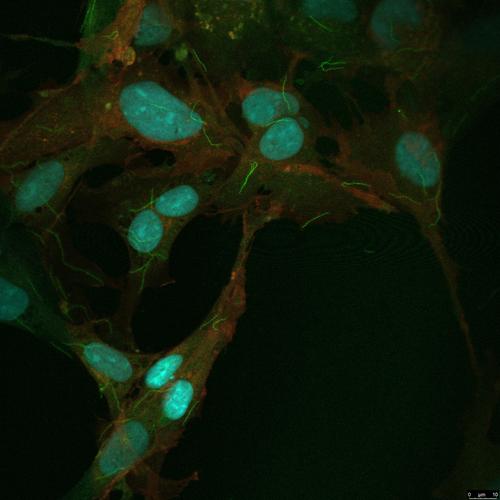当前位置:
X-MOL 学术
›
Mol. Microbiol.
›
论文详情
Our official English website, www.x-mol.net, welcomes your
feedback! (Note: you will need to create a separate account there.)
Bright New Resources for Syphilis Research: Genetically Encoded Fluorescent Tags for Treponema pallidum and Sf1Ep Cells
Molecular Microbiology ( IF 2.6 ) Pub Date : 2024-08-08 , DOI: 10.1111/mmi.15304 Linda Grillová 1 , Emily Romeis 2 , Nicole A P Lieberman 3 , Lauren C Tantalo 2 , Linda H Xu 2 , Barbara Molini 2 , Aldo T Trejos 2, 4 , George Lacey 1 , David Goulding 1 , Nicholas R Thomson 1, 5 , Alexander L Greninger 3, 6 , Lorenzo Giacani 2, 4
Molecular Microbiology ( IF 2.6 ) Pub Date : 2024-08-08 , DOI: 10.1111/mmi.15304 Linda Grillová 1 , Emily Romeis 2 , Nicole A P Lieberman 3 , Lauren C Tantalo 2 , Linda H Xu 2 , Barbara Molini 2 , Aldo T Trejos 2, 4 , George Lacey 1 , David Goulding 1 , Nicholas R Thomson 1, 5 , Alexander L Greninger 3, 6 , Lorenzo Giacani 2, 4
Affiliation

|
The recently discovered methodologies to cultivate and genetically manipulate Treponema pallidum subsp. pallidum (T. pallidum) have significantly helped syphilis research, allowing the in vitro evaluation of antibiotic efficacy, performance of controlled studies to assess differential treponemal gene expression, and generation of loss-of-function mutants to evaluate the contribution of specific genetic loci to T. pallidum virulence. Building on this progress, we engineered the T. pallidum SS14 strain to express a red-shifted green fluorescent protein (GFP) and Sf1Ep cells to express mCherry and blue fluorescent protein (BFP) for enhanced visualization. These new resources improve microscopy- and cell sorting–based applications for T. pallidum, better capturing the physical interaction between the host and pathogen, among other possibilities. Continued efforts to develop and share new tools and resources are required to help our overall knowledge of T. pallidum biology and syphilis pathogenesis reach that of other bacterial pathogens, including spirochetes.
中文翻译:

梅毒研究的光明新资源:梅毒螺旋体和 Sf1Ep 细胞的基因编码荧光标签
最近发现的培养和遗传操作梅毒螺旋体梅毒螺旋体亚种 (T. pallidum) 的方法极大地 帮助了梅毒研究,允许体外评估抗生素疗效,进行对照研究以评估梅毒螺旋体基因表达的差异,以及功能丧失突变体的产生以评估特定遗传位点对梅毒螺旋体的贡献毒性。基于这一进展,我们设计了梅毒螺旋体 SS14 菌株来表达红移绿色荧光蛋白 (GFP),设计了 Sf1Ep 细胞来表达 mCherry 和蓝色荧光蛋白 (BFP) 以增强可视化。这些新资源改进了梅毒螺旋体基于显微镜和细胞分选的应用,更好地捕捉宿主和病原体之间的物理相互作用,以及其他可能性。需要继续努力开发和共享新的工具和资源,以帮助我们对梅毒螺旋体生物学和梅毒发病机制的整体了解达到其他细菌病原体(包括螺旋体)的水平。
更新日期:2024-08-08
中文翻译:

梅毒研究的光明新资源:梅毒螺旋体和 Sf1Ep 细胞的基因编码荧光标签
最近发现的培养和遗传操作梅毒螺旋体梅毒螺旋体亚种 (T. pallidum) 的方法极大地 帮助了梅毒研究,允许体外评估抗生素疗效,进行对照研究以评估梅毒螺旋体基因表达的差异,以及功能丧失突变体的产生以评估特定遗传位点对梅毒螺旋体的贡献毒性。基于这一进展,我们设计了梅毒螺旋体 SS14 菌株来表达红移绿色荧光蛋白 (GFP),设计了 Sf1Ep 细胞来表达 mCherry 和蓝色荧光蛋白 (BFP) 以增强可视化。这些新资源改进了梅毒螺旋体基于显微镜和细胞分选的应用,更好地捕捉宿主和病原体之间的物理相互作用,以及其他可能性。需要继续努力开发和共享新的工具和资源,以帮助我们对梅毒螺旋体生物学和梅毒发病机制的整体了解达到其他细菌病原体(包括螺旋体)的水平。






























 京公网安备 11010802027423号
京公网安备 11010802027423号